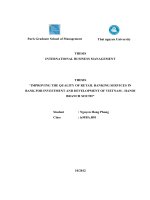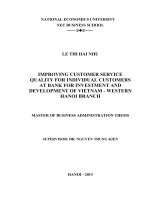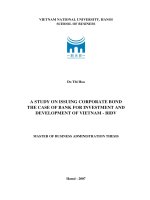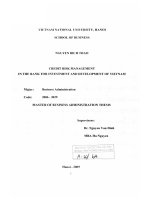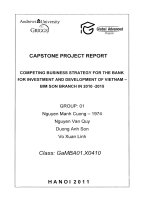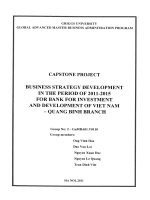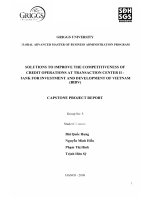Organizational injustice in frontline employees at bank for investment and development of vietnam – south saigon branch
Bạn đang xem bản rút gọn của tài liệu. Xem và tải ngay bản đầy đủ của tài liệu tại đây (1.15 MB, 72 trang )
UNIVERSITY OF ECONOMICS HO CHI MINH CITY
International School of Business
Duong Bao Thinh
ORGANIZATIONAL INJUSTICE
IN FRONTLINE EMPLOYEES
AT BANK FOR INVESTMENT
AND DEVELOPMENT OF VIETNAM
– SOUTH SAIGON BRANCH
MASTER OF BUSINESS ADMINISTRATION
Ho Chi Minh City – 2017
UNIVERSITY OF ECONOMICS HO CHI MINH CITY
International School of Business
Duong Bao Thinh
ORGANIZATIONAL INJUSTICE
IN FRONTLINE EMPLOYEES
AT BANK FOR INVESTMENT
AND DEVELOPMENT OF VIETNAM
– SOUTH SAIGON BRANCH
ID: 22140046
MASTER OF BUSINESS ADMINISTRATION
SUPERVISOR: DR. NGUYEN PHONG NGUYEN
Ho Chi Minh City – 2017
ORGANIZATIONAL INJUSTICE IN FRONTLINE EMPLOYEES
1
Executive Summary
Frontline employees play a very important role in the performance of bank as they directly
work with customers and produce incomes. Despite having a very good start, recently, Bank
for Investment and Development of Vietnam – South Saigon Branch has to deal with poor
performance, negative behaviors as well as high employee turnover rate. Organizational
injustice in frontline employees is identified as the central problem to this undesired
situation. Four elements are considered to be the antecedents of this organizational injustice,
they include poor performance rating system, lack of employees’ participation, low
communication quality and poor implementation. However, after considering the applicable
ability at the branch, one cause is taken into investigation which is poor performance rating
system. The set of four possible solutions is evaluated, three of them (redesigning the
performance appraisal system, raters training and cross-department appraisal) are selected to
solve the central problem. This project is estimated to gain a net saving of approximately
400,000,000 VND over 3 months of testing and 6 months of officially applying with the
initial investment of 100,000,000 VND.
ORGANIZATIONAL INJUSTICE IN FRONTLINE EMPLOYEES
2
Table of Contents
Executive Summary .................................................................................................................1
Table of Contents .....................................................................................................................2
List of Tables ............................................................................................................................4
List of Figures ..........................................................................................................................5
CHAPTER 1: BACKGROUND ..............................................................................................6
1. Company Background .......................................................................................................6
1.1.
BIDV Overview ......................................................................................................6
1.2.
BIDV – South Saigon Branch Overview ................................................................8
2. Symptoms ........................................................................................................................10
3. Problem Identification .....................................................................................................14
CHAPTER 2: PROBLEM JUSTIFICATION .......................................................................17
1. Problem Definition ..........................................................................................................17
2. Problem Existence ...........................................................................................................19
3. Problem Importance ........................................................................................................24
CHAPTER 3: CAUSES VALIDATION AND SOLUTIONS ..............................................27
1. Possible Causes................................................................................................................27
1.1.
Performance Rating System ..................................................................................27
1.2.
Employee Participation .........................................................................................29
1.3.
Communication .....................................................................................................31
1.4.
Implementation ......................................................................................................32
2. Causes Validation ............................................................................................................37
ORGANIZATIONAL INJUSTICE IN FRONTLINE EMPLOYEES
3
3. Solution Design ...............................................................................................................39
3.1.
Possible Solutions..................................................................................................39
3.2.
Evaluation of Solutions .........................................................................................44
3.3.
Change Plan ...........................................................................................................51
Conclusion ..............................................................................................................................55
References ..............................................................................................................................56
Appendix A ............................................................................................................................60
Transcript 1: Thao – Retail Banking Officer ....................................................................60
Transcript 2: Thoa – Teller (Ex-MHB Employee) ...........................................................61
Transcript 3: Vinh – Corporate Banking Officer (Resigned) ...........................................62
Transcript 4: Quoc – Retail Banking Officer (Resigned) .................................................63
Transcript 5: Tran – Human Resources Manager .............................................................65
Appendix B.............................................................................................................................67
Appendix C.............................................................................................................................69
ORGANIZATIONAL INJUSTICE IN FRONTLINE EMPLOYEES
4
List of Tables
Table 1. BIDV South Saigon Branch SWOT Analysis...........................................................9
Table 2. Change in Fixed Deposit Balance of Retail Sector .................................................10
Table 3. 10 Branches with Worst Retail Credit Net Interest Margin ....................................11
Table 4. 10 Branches with Worst Retail Credit Outstanding Growth ..................................11
Table 5. BIDV Capital Mobilization Per Retail Employee in Ho Chi Minh City 2016 .......12
Table 6. BIDV South Saigon Retail Indexes as of 31/08/2016.............................................22
Table 7. Highlight Opinions from Informants ......................................................................22
Table 8. Summary of Interviewees’ Sentiments and Potential Causes .................................35
Table 9. Estimated Cost and Benefit of Solutions ................................................................50
ORGANIZATIONAL INJUSTICE IN FRONTLINE EMPLOYEES
5
List of Figures
Figure 1. BIDV – South Saigon Branch structure....................................................................8
Figure 2. Potential Problems. .................................................................................................15
Figure 3. Organizational Justice Tree. ...................................................................................17
Figure 4. Components of Organizational Justice Theory. ......................................................19
Figure 5. Updated Cause and Effect Tree. .............................................................................36
Figure 6. Causes Types. .........................................................................................................37
Figure 7. Final Cause and Effect Tree....................................................................................38
Figure 8. Proposed Cross-Department Appraisal Model for Corporate Marketing
Department. ............................................................................................................................44
ORGANIZATIONAL INJUSTICE IN FRONTLINE EMPLOYEES
6
CHAPTER 1: BACKGROUND
1. Company Background
1.1. BIDV Overview
The Joint Stock Commercial Bank for Investment and Development of Vietnam
(hereinafter shortly referred to as BIDV) – the longest established bank in Vietnam – was
founded on 26 April 1957 as the Bank for Construction of Vietnam. It operated under that
name until 24 June 1981. In 1981, it changed its name to the Bank for Investment and
Construction of Vietnam. It adopted the present name on 14 November 19901.
In January 2007, the Vietnamese government announced that it would sell stakes in
four state-owned banks, including BIDV – one of the biggest lenders. However, the
government continues to hold a majority stake in these banks.
In December 2011, BIDV achieved a significant transformation in the development
process with a successful IPO, officially becoming a joint stock commercial bank in May
2012. On 24 January 2014, BIDV successfully listed all of its 2,811,202,644 shares on the
Ho Chi Minh City Stock Exchange. The bank’s shares ranked sixth in capitalization value
among listed companies on the VN-Index2.
From a single owner, single-function bank, BIDV has risen strongly and overcome
many difficulties to grow and affirm its position in the economic market. BIDV has made
great contributions to both the development of Vietnam and the relations between Vietnam
and countries around the world.
The bank’s efforts were recognized not only by leaders of the Vietnamese
government but also by international leaders. In 2015, BIDV celebrated its 20th anniversary
ORGANIZATIONAL INJUSTICE IN FRONTLINE EMPLOYEES
7
operating as a fully commercial bank, as well as international integration into the economic
market3.
BIDV is among the largest banks in Vietnam with about 23,000 employees. It has
grown to become one of the leading commercial banks in Vietnam. BIDV offers full
banking products and services including deposits, loans, e-banking, guarantees, trade
finance… The bank boasts subsidiaries in finance, banking, securities and insurance.
BIDV has expanded its business to the international markets including Lao PDR,
Cambodia, Myanmar, Czech Republic, Russia Federation and Taiwan. As well as leading
the way in terms of links with foreign countries, the bank joined hands with local
governments to hold conferences and forums with the aim of promoting their potential for a
more prosperous Vietnam.
On 25 May 2015, Mekong Housing Bank (MHB) officially merged with BIDV. As
of the end of 2015, BIDV’s total assets were VND 857 trillion (USD 38.3 billion). As of 30
September 2016, total assets reached VND 956 trillion (USD 42.9 billion), up 11.5 percent
year-to-date, making BIDV the largest bank in Vietnam by total assets3.
In 2016, BIDV has also received prestigious awards from several organizations.
These included highest taxpayer in Vietnam; TOP global 2,000 largest public companies as
voted by Forbes; 11 fixed income poll awards from Asiamoney; Best Retail Bank in
Vietnam 2016 as voted by The Asian Banker; highly commended award: Excellence in
social media – customer relations & brand engagement as voted by Retail Banker
International and the Vietnam excellent brand awarded by Vietnam Economic Times3.
ORGANIZATIONAL INJUSTICE IN FRONTLINE EMPLOYEES
8
1.2. BIDV – South Saigon Branch Overview
BIDV – South Saigon Branch was established in November 2010 with more than 110
employees. It has one head office and four transaction offices located in district 4 and
district 7. The branch’s customers widely spread from millions of individuals to enterprises
and large corporations.
BIDV – South Saigon Branch
Front office
Retail
marketing
Corporate
banking
District 7
transaction
office
Back office
Individual
customer
services
Khanh Hoi
transaction
office
Corporate
customer
services
Dan Sinh
transaction
office
Transactions
offices
Nguyen Van Linh
transaction office
Figure 1. BIDV – South Saigon Branch structure.
In 2015, BIDV – South Saigon Branch received the award for Excellent Branch in
Southern Area.
As of the end of 2016, the branch’s deposits were VND 5,500 billion while total
loans were over VND 12,000 billion. Services net income in 2016 reached about VND 28.5
billion, accounted for 21% total net income.
ORGANIZATIONAL INJUSTICE IN FRONTLINE EMPLOYEES
9
In 5 years, BIDV – South Saigon branch has recorded a significant development in
loans, deposits and services… Its financial performance has outrun many long-established
branches.
The branch’s mission is to provide the highest standard of modern financial banking
services to customers; to create a professional and friendly working environment with ample
career opportunities and benefits for all employees, and to be pioneering in community
development activities2.
Table 1.
BIDV South Saigon Branch SWOT Analysis
Strengths
Weaknesses
Opportunities
•
One of the largest and well-known banks in Vietnam.
•
Large customer base.
•
Wide branches network all over the country.
•
High quality employees (in term of academic standard).
•
Profit sources are not diversified, mostly from credit services.
•
Deposits is decreasing, especially from individuals.
•
Slow adapt to market changes.
•
Support from the government/ministry of finance.
•
Credit/new banking service needs are increasing.
•
Low competition in some market/services: investment banking, asset
management, derivatives…
Threats
•
High competition from other rivals.
•
Uncomprehensive legal/regulatory.
ORGANIZATIONAL INJUSTICE IN FRONTLINE EMPLOYEES
10
2. Symptoms
Although BIDV – South Saigon Branch was doing quite well in the past years, since
2016, based on the reports done by headquarters and branch’s financial performance as well
as staff feedbacks on internal website and via meetings, there are five salient issues that
have badly affected the branch performance: (1) Slow change in interest rate which makes
our interest rates less competitive to other rivals, (2) Complex process of derivatives
services, (3) Employees’ attitudes with customers, (4) Employee frustration, (5) High
employee turnover.
As issues (1) Slow change in interest rate and (2) Complex process of derivatives
services are related to headquarters policy and administration, we cannot impact on these
issues from the stand point of a branch. Moreover, the frequency of customers’ complaints
as well as faulty operations is more often lately. Hence, this paper is going to focus on the
issue of employees’ attitude, frustration and turnover, especially those who are directly
interacting with customers.
Recently, more and more customers complain about poor quality of service and
attitude of the frontline employees. Some customers switch to another branch or even leave
for other banks. This situation has led to a dramatically drop on deposit balance and credit
profits, especially in retail banking sector.
Table 2.
Change in Fixed Deposit Balance of Retail Sector
Fixed deposit (in billions VND)
Q3/2015
Q1/2016
Change
2,430
2,389
-41
ORGANIZATIONAL INJUSTICE IN FRONTLINE EMPLOYEES
11
Table 3.
10 Branches with Worst Retail Credit Net Interest Margin
Rank
Branch
Retail credit net interest margin as of Q1/2017
1
Quang Trung
-3.66%
2
South West
-0.95%
3
Vung Tau
-0.42%
4
North Hanoi
0.29%
5
Hiep Phu Saigon
0.49%
6
Ben Thanh
0.68%
7
Dai La
0.76%
8
Thu Thiem
0.86%
9
South Saigon
0.91%
10
East Hanoi
0.96%
Note. Adapted from BIDV internal report 2017
Table 4.
10 Branches with Worst Retail Credit Outstanding Growth
Retail credit outstanding (in billions VND)
Rank
Branch
Q4/2016
Q1/2017
Change
638
556
-82
1
South Saigon
2
Gia Dinh
1,078
1,006
-72
3
Quang Trung
1,837
1,768
-69
4
Ha Long
794
731
-63
5
Hoan Kiem
999
958
-41
6
Ben Tre
1,066
1,030
-36
ORGANIZATIONAL INJUSTICE IN FRONTLINE EMPLOYEES
12
Retail credit outstanding (in billions VND)
Rank
Branch
Q4/2016
Q1/2017
Change
7
Nam Ky Khoi Nghia
601
567
-34
8
Thai Binh
860
829
-32
9
Bao Loc
2,299
2,268
-31
10
Ho Chi Minh City
1,394
1,362
-31
Note. Adapted from BIDV internal report 2017
As an indispensable result, the branch net profit has gone bad (below target) from the
beginning of 2016 and receive a low rank in comparison with other branches especially in
retail banking area.
Table 5.
BIDV Capital Mobilization Per Retail Employee in Ho Chi Minh City 2016
Rank
Branch
Capital mobilization per retail employee (in billions VND)
1
West Saigon
335
2
Saigon
140
3
No. 2 Center Transaction
139
4
Cho Lon
139
5
Ho Chi Minh City
128
6
East Saigon
112
7
Gia Dinh
98
8
Ba Thang Hai
98
9
Phu Nhuan
95
10
Nam Saigon
87
11
Tan Binh
87
12
Ben Thanh
83
ORGANIZATIONAL INJUSTICE IN FRONTLINE EMPLOYEES
Rank
Branch
13
Capital mobilization per retail employee (in billions VND)
13
Nam Ky Khoi Nghia
76
14
North Saigon
72
15
Ben Nghe
62
Note. Adapted from BIDV internal report
Beside poor performance, many frontline employees often express frustration with
customers and colleagues. They tend to give back answers, talk improperly to others and
refuse to do assigned tasks (information collected from reports by secret customers program
and feedbacks from other departments).
In addition, increasing employee turnover has filled our managers with concern. In
less than 12 months, there were up to twelve resignations, nine of them are from frontline
employees while as of the previous year, this figure was just three.
In-depth interviews were conducted with employees to find out the reasons why they
were not satisfied or left the bank. They have shown that frontline employees, to the large
part, are unhappy with their job and some even felt dissatisfied or wanted to find a new job.
Due to downturn in banking industry in recent years, the number of employees has
declined dramatically that make the current employees have to deal with an excessive
amount of work which used to be shared among several staff4. “I don’t feel the motivation
of working here anymore. Every day I just want to get home as soon as possible. … I have
to work without a reasonable job allocation and reward system”, shared by Thao – a senior
retail credit officer. “There are some sorts of issues… and I have to free myself. … What I
got just doesn’t reflect the efforts I put into my work.”, said Vinh – a corporate banking
officer who quit his job. The most common opinions were that they felt too stressful while
ORGANIZATIONAL INJUSTICE IN FRONTLINE EMPLOYEES
14
being treated unappreciatively and rewards were not accordingly distributed among staff as
well as departments. These going issues can definitely decrease employees’ satisfaction and
affect company’s overall performance.
Frontline employees play a very important role in the performance of the bank as
they do the most interacting with customers and receive customers’ responses about bank’s
products or services then contribute significantly to the customers’ access to the services of
the bank5. The importance of frontline employees’ interaction with customers is considered
to be a psychological phenomenon that exerts a major impact upon outcomes. If customer
leaves with a negative impression from the attitude of an employee, other efforts may be
overlooked6. Yavas7 stated that “frontline employees are the most critical link in the
provision of superior service to customers and their actions are also critical for service
recovery when a service failure occurs”. Thus, digging into the reasons and solutions for
these issues is an essential task to help boost the branch performance.
3. Problem Identification
From the defined symptoms, informants gave their own thoughts about what existing
problems our branch is dealing with. Derived from their interviews, work overload and
injustice in the workplace are recognized with initial evidence to prove for the damage to
work quality.
Specifically, Rizwan’s8 research revealed that work overload is positively related to
job-stress in banking sector. According to Yavas7, the existence of job stress leads to several
problems like reduction in employee productivity, job dissatisfaction, low organizational
commitment and propensity to leave the organization, etc.
ORGANIZATIONAL INJUSTICE IN FRONTLINE EMPLOYEES
15
Moreover, organizational injustice has distinct effects on individual and
organizational outcomes including low organizational commitment and job satisfaction,
avoidance behaviors as well as low job performance outcomes (detail analysis is shown in
chapter 2).
From the collected information about the organization’s context, a cause and effect
diagram which enables us to brainstorm and classify the variables that might be causing
poor performance9 is proposed as follow:
Potential problems
Symptoms
Work overload
Low organizational
commitment
Organizational
injustice
Low job satisfaction
Avoidance behaviors
Poor job performance
Figure 2. Potential Problems.
Based on the interviews with some staff of BIDV – South Saigon Branch and due to
constraints in time and resources, this project is proposed to focus on the following
problem: there is injustice among employees in the branch.
There are three main reasons for the above choice:
Firstly, interviews with frontline employees suggest that people are not satisfied with
the method works and rewards are distributed in their department as well as among different
ORGANIZATIONAL INJUSTICE IN FRONTLINE EMPLOYEES
16
departments in the branch; they are also upset with the procedures used to determine the
outcomes that they receive and the ways they are treated by their managers. Detail analysis
is presented in the possible causes below.
Secondly, regarding the scope of my role (planning and financial officer), solving the
problems of work overload and sophisticated working system is not feasible as there is not
enough control over these problems from the branch position. In order to deal with these
problems, we have to work on the policies ad regulations of the whole bank which is not
only affectable by the headquarters but also take a lot of human resources and budget.
Lastly, organizational injustice is a continued existent problem that are found
embedded within policies, procedural practices and organizational culture; this problem
exists in workplaces and affects many, according to Mach-fell10.
The interviews revealed that the lack of organizational justice decreases operational
performance (for example, job completion time and quality) and makes the branch less
competitive than other branches and banks. Thus, the lack of organizational justice is
proposed as the central problem in this project.
ORGANIZATIONAL INJUSTICE IN FRONTLINE EMPLOYEES
17
CHAPTER 2: PROBLEM JUSTIFICATION
1. Problem Definition
Rawls11’ formative theory of justice divided the concept of justice into two
principles: liberty and equality. “The liberty principle argues that every person has certain
basic rights and freedoms and the equality principle asserts that these should be open to any
person regardless of background, ethnicity or gender”11.
Organizational justice is a term that was first used by Greenberg12 to describe
individuals’ perceptions of organizational justice.
Ambrose et al.13 argued that “injustice refers to an employee’s belief that he or she
(or someone else) has been treated unfairly”. Moreover, “an employee who feels unjustly
treated may try to ‘even the score’ by committing sabotage”.
Organizational justice is also stated to be a versatile concept that it covers everything
from system of payment to treatment by boss. Organizational justice is divided into three
different types which are distributive justice, procedural justice, interpersonal justice.
Interactional justice is further divided into interpersonal and informational justice14.
Organizational justice
Distributive justice
Procedural justice
Interactional justice
Interpersonal
justice
Figure 3. Organizational Justice Tree.
Informational
justice
ORGANIZATIONAL INJUSTICE IN FRONTLINE EMPLOYEES
18
Distributive justice refers to an employee’s perceived fairness regarding the
distribution of rewards amongst his or her peers. This was largely based upon the notion of
equity theory, which used social exchange theory to evaluate the fairness as found by
Adams15 and Colquitt16.
Procedural justice refers to the perceptions of employees about the fairness of the
procedures used to determine the outcomes that they receive. This concept was introduced
to highlight disputant reactions to legal procedures by Caldeira et al.17.
Interactional justice refers to employee’s perception of the degree to which he/she is
treated with dignity, concern and respect at the workplace18. This concept was first
introduced by Bies and Moag19 focusing on interpersonal treatment. Interpersonal treatment
has since been categorized further into namely interpersonal justice and informational
justice16. The reason of dividing interactional justice into two subcomponents is that
interactional justice reflects the way authorities communicate in a respectful and proper
manner, and justified decisions using honest and truthful information. However, the respect
and propriety rules are distinct from the justification and truthfulness rules, labeling the
former criteria interpersonal justice and the latter criteria informational justice, as agued by
Greenberg. Interpersonal justice describes the degree to which people are treated with
politeness, degree and respect. Informational justice, on other hand, refers to explanations
ORGANIZATIONAL INJUSTICE IN FRONTLINE EMPLOYEES
19
provided to people that convey information about why procedure was followed on certain
way and why rewards are distributed in particular manner16.
Organizational justice
Distributive justice:
Fairness of decision
outcomes
Procedural justice:
Fairness of decision
making process
Interactional justice:
Empathetic treatment during
the communication process
Figure 4. Components of Organizational Justice Theory. Adapted from Campbell and Finch20.
2. Problem Existence
In order to get rid of the complains of customers, increase employees’ quality and
boost the branch overall performance, after defining the problem, we have to validate it to
judge whether the problem is a real problem which refers to a situation that in reality does
not meet realistic standard21.
Colquitt16 designed an organizational justice scale to assess employees’ perceptions
of fairness. This scale consists of four dimensions: distributive, procedural, informational,
and interpersonal justice. Initial interviews were conducted to collect factual information
and they revealed that organizational injustice is an existing issue that hold the branch
performance.
From the work of Colquitt16, organizational justice was defined by 20 items.
Responses to individual items were recorded to justify the presence of injustice in the
organization. This set of questions is chosen to access the organizational justice of frontline
employees through interviews. The answers for these questions are considered for the
ORGANIZATIONAL INJUSTICE IN FRONTLINE EMPLOYEES
20
assessment of organizational justice in frontline employees at BIDV – South Saigon Branch.
This is also used to identified the type of injustice presented (see appendix B for detail).
There are five informants chosen to give information including: Teller, corporate
banking officer, human resources manager and two retail banking officers. The reason of
choosing these interviewees is that they are frontline employees and human resources
manager, the central objects of this research and have at least 1-year experience working at
BIDV – South Saigon Branch.
Some staff feel that their contribution does not have a corresponding reward. “I was
still a normal officer after those sacrifices. What I got just doesn’t reflect the efforts I put
into my work” said Vinh – a corporate banking officer who quit his job. He feels that there
is a lack of fairness regarding the distribution of rewards in comparison with his peers.
Moreover, he also had to deal with the decisions of the appraisal process. He expected
higher ratings but what he received was not justified, given his performance. This generally
shows that the employee’s perception holds about the bank as being unfair which is
similarly described as organizational injustice by Mathur22.
Moreover, employees who are not satisfied with their performance appraisal usually
refer to organizational injustice as per described by that there is a positive link between
organizational justice and satisfaction with various elements of performance appraisal23. For
instance, Thoa – who used to be an MHB employee – could not find the passion of working
any more since the merger of MHB and BIDV, she had to accept a lower position with a
much lower salary while the amount of work she was in charge of was the same or
sometimes more than the BIDV staff. She shared: “Compare to what I have to sacrifice; the
ORGANIZATIONAL INJUSTICE IN FRONTLINE EMPLOYEES
21
compensation is a big letdown”; “I think this way of judging new merger staff is not
reasonable because they may not have those kinds of certificates but with their wide range
of experience they can still get the job done nicely”. In fact, most of the new merger staff
has to receive a salary index under 1.6 while the majority of original BIDV staff salary
index is more than 2.15.
The interviews also revealed that organizational justice level has been rather low in
the context of the distribute the workload, as proved by Quoc – a retail banking officer:
“When he (his manager) decided to put me in the credit card group, he just did it without
inform me in advance. I mean it’s his right but I need time to prepare for a new role and
reorder my other duties and I also want to give my own opinions. It would be better if he
offers more explanation in a clear manner”; “there are 4 credit officers in my department but
I have to take 40% of the workload”.
These observations are in line with the conclusion of Mahajan and Benson that
“researchers have found distinct effects of distributive, procedural and interactional justice
on several individual and organizational outcomes”24.
As a matter of fact, the above issues really happened in reality and lead to a
significant decrease in growth of deposit, loan and service income and an increase in costs
for finding new customers which then threaten the mission of the branch as well as BIDV in
general (to be the leader of commercial banks in Vietnam). All retail indexes are far below
target.
ORGANIZATIONAL INJUSTICE IN FRONTLINE EMPLOYEES
22
Table 6.
BIDV South Saigon Retail Indexes as of 31/08/2016
No.
Item
Absolute value
(in billions VND)
2016 target
Target completed
1
Retail net income
40.9
71.1
57%
2
Retail service net income
3.19
6.31
50%
3
Retail deposits
2,826
3,550
23%
4
Retail loans
576
724
55%
In conclusion, the existence of organizational injustice at BIDV – South Saigon
Branch is confirmed through the interviews with four employees of frontline area and one
human resources manager. Below are some highlight opinions from the informants which
are mainly complains about the unfairness in the branch:
Table 7.
Highlight Opinions from Informants
No.
Interviewee
1
Thao – Retail
banking officer
2
Thoa – Teller
(ex-MHB
employee)
Question
Answer
•
What do you think of your
salary?
•
•
Why don’t you talk with
your supervisor?
•
•
How about the reward
policy?
•
•
What do you think about
the new regulations?
•
I have to call it unfairness… my
payment is much lower…
•
Have you try talking to
your manager?
•
I think that conversation did not
get me any change… this job is
getting to interfere with my
family life.
The company pay me base on the
job description but in fact I have
to do the job of a specialist.
I did talk to him but nothing
changes. He seems to give no
care about this situation.
Completely unfair.
ORGANIZATIONAL INJUSTICE IN FRONTLINE EMPLOYEES
No.
3
4
5
Interviewee
Vinh –
Corporate
banking officer
(resigned)
Quoc – Retail
banking officer
(Resigned)
Tran – Human
resources
manager
Question
23
Answer
•
I heard that since the end
of 2015, MHB staff and
BIDV staff are treated
equally?
•
None of MHB’s employees have
the same payment as BIDV’s… I
think this way of judging new
merger staff is not reasonable…
•
What do you think of these
duties?
•
I had to work up to 10 – 12 hours
and that made me exhausted.
•
What do you mean you
were not appreciated?
•
What I got just doesn’t reflect the
efforts I put into my work.
•
Have you ever try sharing
your though with your
supervisor?
•
•
How about the way that the
manager treated you?
•
I couldn’t express my views and
feeling during my works… I have
no influence over the process of
my work.
My supervisor seemed to be quite
cold… I prefer a politer manner
•
How did your new
manager treat you?
•
•
You said that the rewards
you receive are not fair.
Could you tell me more
detail about that?
•
•
Why don’t you raise your
voice?
•
•
Could you be more specific
about this concern (the
relationship between
managers and employees)
please?
Do you have any idea that
front line employees tend
to have a higher ratio of
quitting job?
•
The way some of our managers
operated works was not highly
appreciated by employees.
•
Someone with a lighter piece of
work got the same rewards makes
them feel unfairly treated.
•
He should talk with his staff
before making any decision about
their job… he always decides on
his own.
The rewards were identically
divided to all the people in my
department… I just want it to be
distributed based on what people
contributed…
I am kind of afraid of being
offensive.
